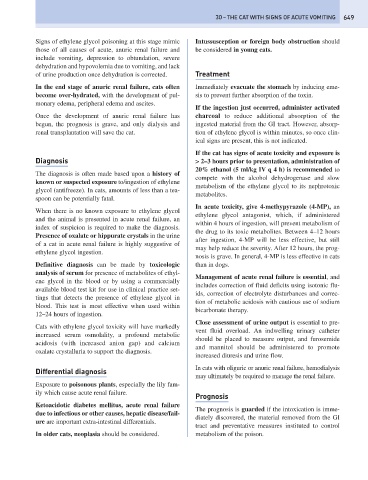Page 657 - Problem-Based Feline Medicine
P. 657
30 – THE CAT WITH SIGNS OF ACUTE VOMITING 649
Signs of ethylene glycol poisoning at this stage mimic Intussusception or foreign body obstruction should
those of all causes of acute, anuric renal failure and be considered in young cats.
include vomiting, depression to obtundation, severe
dehydration and hypovolemia due to vomiting, and lack
of urine production once dehydration is corrected. Treatment
In the end stage of anuric renal failure, cats often Immediately evacuate the stomach by inducing eme-
become over-hydrated, with the development of pul- sis to prevent further absorption of the toxin.
monary edema, peripheral edema and ascites.
If the ingestion just occurred, administer activated
Once the development of anuric renal failure has charcoal to reduce additional absorption of the
begun, the prognosis is grave, and only dialysis and ingested material from the GI tract. However, absorp-
renal transplantation will save the cat. tion of ethylene glycol is within minutes, so once clin-
ical signs are present, this is not indicated.
If the cat has signs of acute toxicity and exposure is
Diagnosis > 2–3 hours prior to presentation, administration of
20% ethanol (5 ml/kg IV q 4 h) is recommended to
The diagnosis is often made based upon a history of
compete with the alcohol dehydrogenase and slow
known or suspected exposure to/ingestion of ethylene
metabolism of the ethylene glycol to its nephrotoxic
glycol (antifreeze). In cats, amounts of less than a tea-
metabolites.
spoon can be potentially fatal.
In acute toxicity, give 4-methypyrazole (4-MP), an
When there is no known exposure to ethylene glycol
ethylene glycol antagonist, which, if administered
and the animal is presented in acute renal failure, an
within 4 hours of ingestion, will prevent metabolism of
index of suspicion is required to make the diagnosis.
the drug to its toxic metabolites. Between 4–12 hours
Presence of oxalate or hippurate crystals in the urine
after ingestion, 4-MP will be less effective, but still
of a cat in acute renal failure is highly suggestive of
may help reduce the severity. After 12 hours, the prog-
ethylene glycol ingestion.
nosis is grave. In general, 4-MP is less effective in cats
Definitive diagnosis can be made by toxicologic than in dogs.
analysis of serum for presence of metabolites of ethyl-
Management of acute renal failure is essential, and
ene glycol in the blood or by using a commercially
includes correction of fluid deficits using isotonic flu-
available blood test kit for use in clinical practice set-
ids, correction of electrolyte disturbances and correc-
tings that detects the presence of ethylene glycol in
tion of metabolic acidosis with cautious use of sodium
blood. This test is most effective when used within
bicarbonate therapy.
12–24 hours of ingestion.
Close assessment of urine output is essential to pre-
Cats with ethylene glycol toxicity will have markedly
vent fluid overload. An indwelling urinary catheter
increased serum osmolality, a profound metabolic
should be placed to measure output, and furosemide
acidosis (with increased anion gap) and calcium
and mannitol should be administered to promote
oxalate crystalluria to support the diagnosis.
increased diuresis and urine flow.
In cats with oliguric or anuric renal failure, hemodialysis
Differential diagnosis
may ultimately be required to manage the renal failure.
Exposure to poisonous plants, especially the lily fam-
ily which cause acute renal failure.
Prognosis
Ketoacidotic diabetes mellitus, acute renal failure
The prognosis is guarded if the intoxication is imme-
due to infectious or other causes, hepatic disease/fail-
diately discovered, the material removed from the GI
ure are important extra-intestinal differentials.
tract and preventative measures instituted to control
In older cats, neoplasia should be considered. metabolism of the poison.

